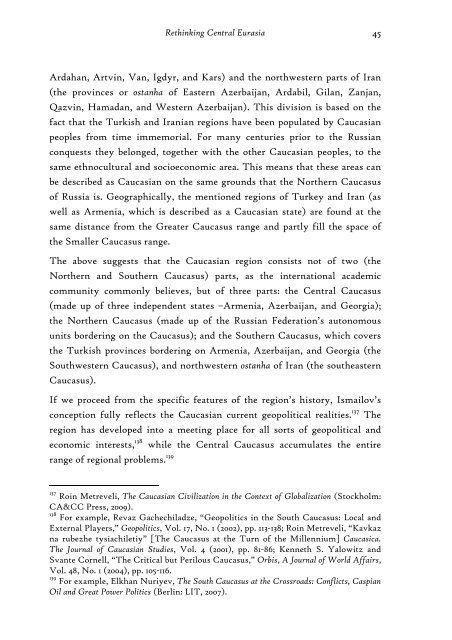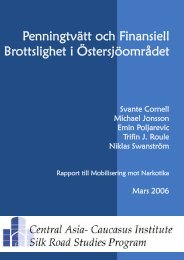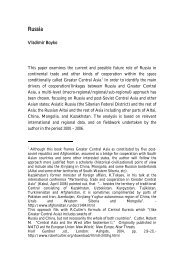Eurasianism and the Concept of Central Caucaso-Asia
Eurasianism and the Concept of Central Caucaso-Asia
Eurasianism and the Concept of Central Caucaso-Asia
You also want an ePaper? Increase the reach of your titles
YUMPU automatically turns print PDFs into web optimized ePapers that Google loves.
Rethinking <strong>Central</strong> Eurasia 45<br />
Ardahan, Artvin, Van, Igdyr, <strong>and</strong> Kars) <strong>and</strong> <strong>the</strong> northwestern parts <strong>of</strong> Iran<br />
(<strong>the</strong> provinces or ostanha <strong>of</strong> Eastern Azerbaijan, Ardabil, Gilan, Zanjan,<br />
Qazvin, Hamadan, <strong>and</strong> Western Azerbaijan). This division is based on <strong>the</strong><br />
fact that <strong>the</strong> Turkish <strong>and</strong> Iranian regions have been populated by Caucasian<br />
peoples from time immemorial. For many centuries prior to <strong>the</strong> Russian<br />
conquests <strong>the</strong>y belonged, toge<strong>the</strong>r with <strong>the</strong> o<strong>the</strong>r Caucasian peoples, to <strong>the</strong><br />
same ethnocultural <strong>and</strong> socioeconomic area. This means that <strong>the</strong>se areas can<br />
be described as Caucasian on <strong>the</strong> same grounds that <strong>the</strong> Nor<strong>the</strong>rn Caucasus<br />
<strong>of</strong> Russia is. Geographically, <strong>the</strong> mentioned regions <strong>of</strong> Turkey <strong>and</strong> Iran (as<br />
well as Armenia, which is described as a Caucasian state) are found at <strong>the</strong><br />
same distance from <strong>the</strong> Greater Caucasus range <strong>and</strong> partly fill <strong>the</strong> space <strong>of</strong><br />
<strong>the</strong> Smaller Caucasus range.<br />
The above suggests that <strong>the</strong> Caucasian region consists not <strong>of</strong> two (<strong>the</strong><br />
Nor<strong>the</strong>rn <strong>and</strong> Sou<strong>the</strong>rn Caucasus) parts, as <strong>the</strong> international academic<br />
community commonly believes, but <strong>of</strong> three parts: <strong>the</strong> <strong>Central</strong> Caucasus<br />
(made up <strong>of</strong> three independent states –Armenia, Azerbaijan, <strong>and</strong> Georgia);<br />
<strong>the</strong> Nor<strong>the</strong>rn Caucasus (made up <strong>of</strong> <strong>the</strong> Russian Federation’s autonomous<br />
units bordering on <strong>the</strong> Caucasus); <strong>and</strong> <strong>the</strong> Sou<strong>the</strong>rn Caucasus, which covers<br />
<strong>the</strong> Turkish provinces bordering on Armenia, Azerbaijan, <strong>and</strong> Georgia (<strong>the</strong><br />
Southwestern Caucasus), <strong>and</strong> northwestern ostanha <strong>of</strong> Iran (<strong>the</strong> sou<strong>the</strong>astern<br />
Caucasus).<br />
If we proceed from <strong>the</strong> specific features <strong>of</strong> <strong>the</strong> region’s history, Ismailov’s<br />
conception fully reflects <strong>the</strong> Caucasian current geopolitical realities. 137 The<br />
region has developed into a meeting place for all sorts <strong>of</strong> geopolitical <strong>and</strong><br />
economic interests, 138 while <strong>the</strong> <strong>Central</strong> Caucasus accumulates <strong>the</strong> entire<br />
range <strong>of</strong> regional problems. 139<br />
137<br />
Roin Metreveli, The Caucasian Civilization in <strong>the</strong> Context <strong>of</strong> Globalization (Stockholm:<br />
CA&CC Press, 2009).<br />
138<br />
For example, Revaz Gachechiladze, “Geopolitics in <strong>the</strong> South Caucasus: Local <strong>and</strong><br />
External Players,” Geopolitics, Vol. 17, No. 1 (2002), pp. 113-138; Roin Metreveli, “Kavkaz<br />
na rubezhe tysiachiletiy” [The Caucasus at <strong>the</strong> Turn <strong>of</strong> <strong>the</strong> Millennium] Caucasica.<br />
The Journal <strong>of</strong> Caucasian Studies, Vol. 4 (2001), pp. 81-86; Kenneth S. Yalowitz <strong>and</strong><br />
Svante Cornell, “The Critical but Perilous Caucasus,” Orbis, A Journal <strong>of</strong> World Affairs,<br />
Vol. 48, No. 1 (2004), pp. 105-116.<br />
139<br />
For example, Elkhan Nuriyev, The South Caucasus at <strong>the</strong> Crossroads: Conflicts, Caspian<br />
Oil <strong>and</strong> Great Power Politics (Berlin: LIT, 2007).






